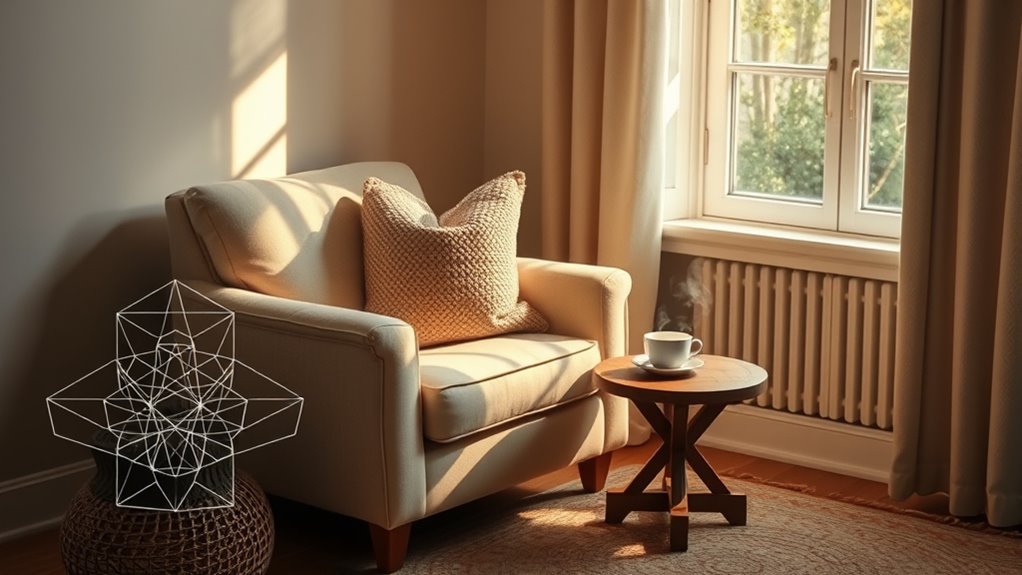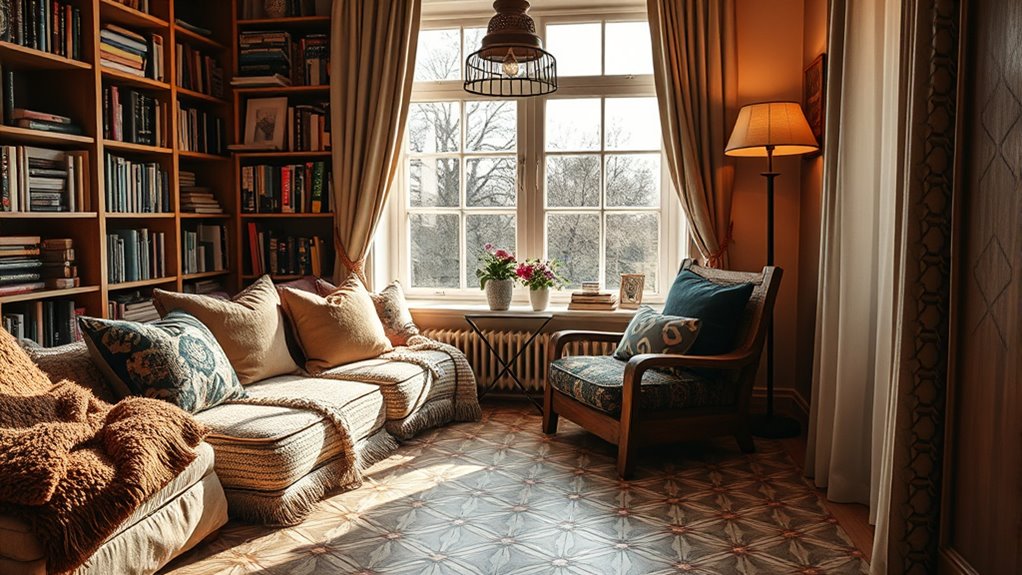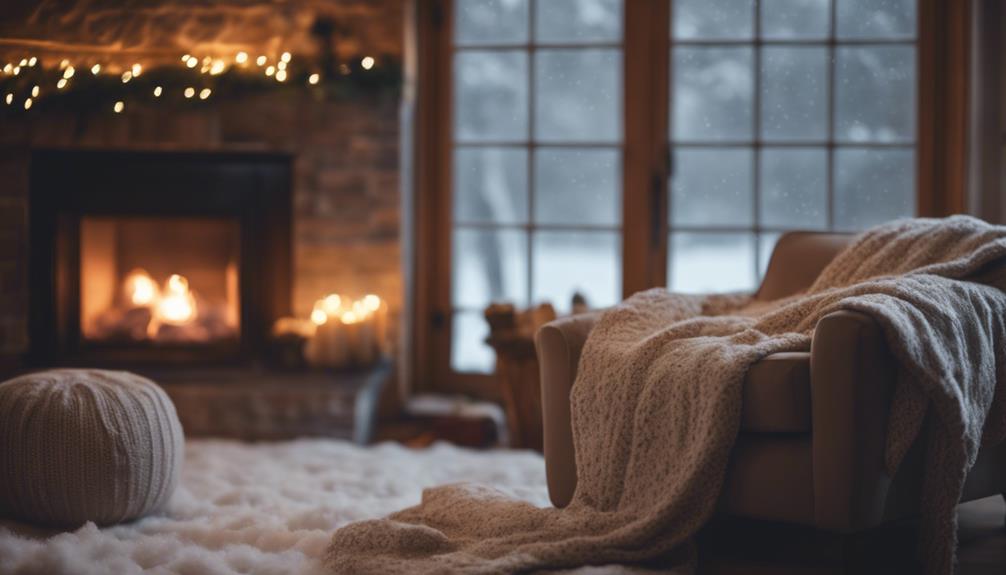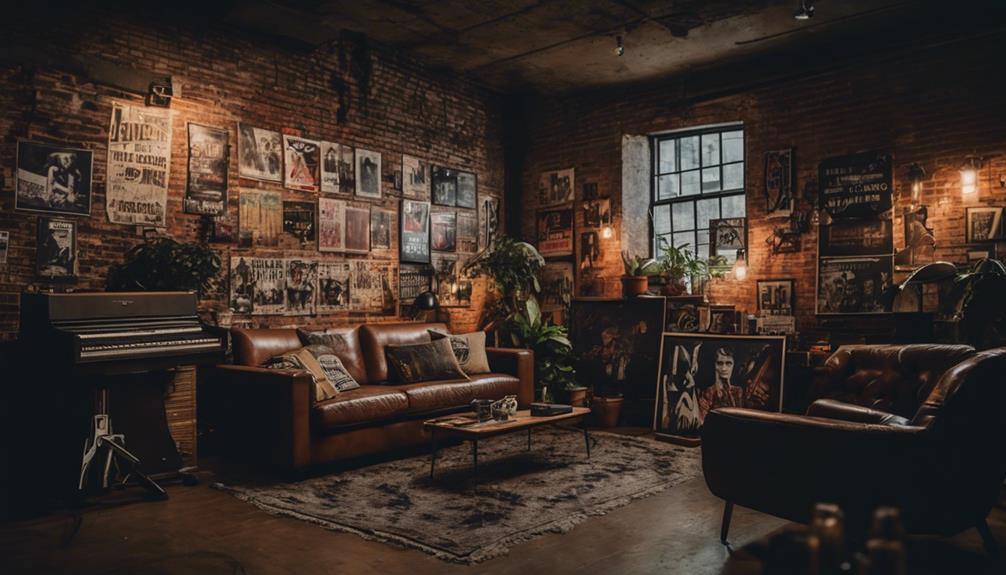The secret to cozy rooms lies in subtle geometric harmony and color choices. You’ll notice that symmetrical layouts, rounded furniture, and soft edges create a sense of stability and comfort. Warm, muted tones enhance feelings of security, while unobstructed pathways promote ease of movement. Together, these design elements work unconsciously to make a space feel inviting and safe. If you want to discover how these details shape your environment, keep exploring how design influences your mood.
Key Takeaways
- Symmetrical layouts and balanced proportions create visual stability, making rooms feel grounded and secure.
- Rounded furniture and soft edges promote comfort and reduce tension, enhancing coziness.
- Proper scale and arrangement guide the eye smoothly, fostering relaxation and harmony.
- Strategic placement of colors and geometric shapes subconsciously evoke warmth and safety.
- Harmonious spatial flow and gentle curves work together to craft a welcoming, restful environment.

Have you ever wondered what makes a room feel truly cozy? It’s not just about soft blankets or warm lighting — there’s a subtle, often unnoticed, geometry at play. The secret lies in how the elements of a room are arranged, guided by principles like color psychology and spatial flow. When these factors align, your space naturally feels inviting, safe, and comforting.
Color psychology plays a critical role in creating that cozy vibe. Warm, muted tones like soft browns, gentle beiges, and deep terracotta evoke feelings of warmth and security. These hues don’t just look good; they influence your mood and perception of space. If the walls are painted in calming shades, you’re more likely to relax and feel at home. Bright, jarring colors tend to energize or disrupt, making a room feel less cozy. By understanding how certain colors evoke emotions, you can design a room that gently draws you in.
Warm, muted tones like browns and beiges create cozy, inviting spaces that soothe the mind and nurture relaxation.
But color isn’t enough on its own. Spatial flow shapes how you move through and experience a room. When a space is arranged with a clear, logical flow, it encourages a sense of ease and comfort. Think about furniture placement: sofas and chairs arranged in conversational groups, pathways that are unobstructed, and focal points that guide your eye naturally. If your room feels cluttered or awkwardly arranged, it creates a sense of chaos that destroys coziness. Instead, aim for a layout that feels natural and intuitive, allowing you to move smoothly from one area to another without resistance. This flow makes the space feel balanced and harmonious, essential ingredients for coziness.
The geometry of your room, including how you position furniture and select colors, directly impacts this flow. Symmetry and proportion help create visual stability, making the space feel grounded and secure. Rounded furniture or soft edges can enhance this effect, as sharp angles might introduce a sense of tension. The way the elements are scaled and arranged influences how your eyes travel across the room, guiding you to feel relaxed rather than overwhelmed. When color and spatial flow work together in harmony, they craft a subconscious rhythm that makes you want to settle in and stay awhile.
Additionally, understanding interior design principles can help you craft spaces that are not only cozy but also functional and aesthetically pleasing. In essence, the secret geometry behind cozy rooms isn’t just about design rules; it’s about understanding how your environment influences your subconscious feelings. When you pay attention to color psychology and create a smooth spatial flow, you’re shaping an atmosphere that invites comfort effortlessly. It’s a subtle artistry that transforms a simple space into a sanctuary — one that beckons you to unwind and feel truly at home.
Frequently Asked Questions
How Does the Golden Ratio Influence Room Layout Comfort?
The golden ratio influences room layout comfort by creating a sense of proportional harmony that feels natural to your eye. When you incorporate Fibonacci spirals or the golden ratio into your space, it guides the placement of furniture and elements, making the room more balanced and inviting. This subtle use of proportions enhances your comfort, making your space feel more cozy and aesthetically pleasing without you even realizing why.
Can Specific Geometric Shapes Improve Room Coziness?
You can definitely improve room coziness with specific geometric shapes. Incorporate furniture arrangement based on circles or rectangles to create a harmonious flow. Use decorative motifs like hexagons or triangles to add visual interest and warmth. These shapes naturally guide the eye, making your space feel more inviting. By thoughtfully selecting and arranging these geometric elements, you enhance comfort and create a cozy, balanced environment you’ll love spending time in.
Do Color Schemes Relate to Geometric Patterns in Cozy Spaces?
Your question about color schemes and geometric patterns in cozy spaces is fascinating—it’s like revealing a secret code for comfort. Color psychology influences how you feel in a room, while pattern repetition creates harmony. When these elements work together, they amplify coziness, turning a simple space into a sanctuary. You’ll notice that thoughtful color choices paired with geometric patterns can make your room feel more inviting and warm than you ever imagined.
Is Symmetry Essential for Creating a Comforting Room Environment?
Symmetry isn’t essential for creating a comforting room. You can achieve balance and harmony through symmetry, which offers a sense of order, or embrace asymmetry for charm and visual interest. It’s about what feels right to you—sometimes, a perfectly balanced space soothes, while other times, subtle asymmetry adds personality. Trust your instincts to craft a cozy environment that reflects your style and promotes relaxation.
How Do Natural Light Angles Interact With Geometric Design?
Imagine a room where sunlight enters through a south-facing window at just the right light angle. You notice how shadow play creates patterns that highlight the room’s geometric design, enhancing its coziness. Natural light interacts with angles to emphasize shapes and textures, making the space feel inviting. This interplay of light angles and shadows not only boosts aesthetic appeal but also shapes your emotional response, making your environment both functional and comforting.
Conclusion
As you step into a cozy room, notice how the gentle curves of the furniture and the perfect angles of the shelves draw your eye in. The hidden geometry creates a warm, inviting space where every line and shape whispers comfort. It’s like a secret code working behind the scenes, making you feel safe and relaxed without you even realizing it. That’s the magic of cozy rooms—crafted with subtle, beautiful geometry just for you.









